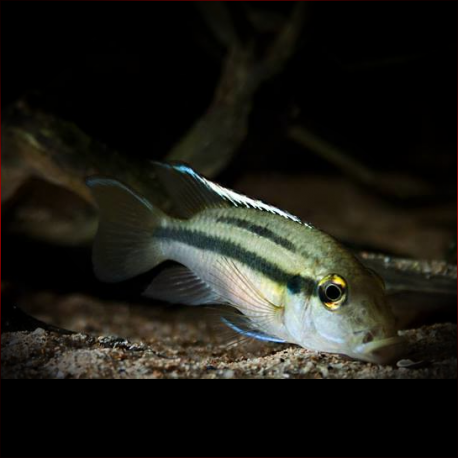More info
Datasheet
| Minimum Tank Size | 160 litres / 42.27 US gallons |
| Maximum Size | 150.0cm / 59.06inches |
| Temperature | 24°C / 75.20°F - 27°C / 80.60°F |
| Hardness | 1.01dgH / 18ppm - 15.02dgH / 268ppm |
| pH | 6.0-8.0 |
General Description
Chromidotilapia Guntheri, commonly known as C. Guntheri, is a species of cichlid with a classification order of Perciformes. Within the family Cichlidae, it belongs to the informally-recognized chromidotilapiine clade. This species, which can grow up to 150.0cm, is widely distributed in coastal river drainages of central western Africa, from the Saint John River in central Liberia to the Cross River drainage in southeastern Nigeria and southwestern Cameroon. There is also a putative subspecies, C. g. loennbergi, endemic to the volcanic crater lake Barombi-ba-Kotto in southwestern Cameroon, categorized as 'Critically Endangered' by the IUCN due to various threats in the region.
Aquarium Setup
For ideal tank setup of C. Guntheri, a soft, sandy substrate is recommended to allow the fish to browse naturally. Additional tank furnishings could include dim lighting, driftwood, scattered roots/branches, and one or two flattish rocks for potential spawning sites. Water quality is crucial, as these cichlids are sensitive to deteriorating water conditions; thus, an efficient filtration system and regular water changes (30-50% of tank volume weekly) are essential. The water parameters should range from 18-268ppm hardness, pH of 6.0-8.0, and a temperature of 24-27°C.
Behaviour
C. Guntheri, although non-aggressive compared to some related species, are not gregarious once they reach adulthood, with paired adults being highly territorial. Thus, it is generally recommended to keep a single pair in most cases. When kept in a community tank, peaceful pelagic characids and cyprinids make excellent tankmates. While breeding, C. Guntheri is best kept alone or with small-mouthed, non-predatory dither fish to avoid aggression and territorial conflicts.
Feeding and Diet
Being benthophagous omnivores, C. Guntheri feeds on small invertebrates, algae, organic detritus, and shrimp eggs. In aquarium settings, they can be fed sinking prepared foods with a high vegetable matter content such as Spirulina, supplemented with occasional live or frozen foods like chironomid larvae, Daphnia, Artemia, or mosquito larvae. Homemade gelatine-bound recipes containing a mix of dried fish food, shellfish, fruits, and vegetables can also be provided in bite-sized pieces.
Reproduction & Dimorphism
The reproductive behavior of C. Guntheri is biparental, paternal, substrate-spawning, and ovophilic mouthbrooding. After fertilization, the male guards the brood in his mouth while the female defends the territory. The fry hatch after 10-14 days and can be fed Artemia nauplii. Following hatching, the fry take refuge in the mouths of both parents when threatened. Sexual dimorphism is seen in the extension of the first pectoral fin ray in males and the coloration differences during spawning, with females displaying a reddish-pink abdomen.
Habitat and Distribution
This species predominantly inhabits lowland environments, including coastal floodplains, savannahs, and forested regions in western Africa. They prefer calmer habitats with submerged cover like tree roots and fallen branches. Endemic to various river systems and lake environments in countries such as Cameroon, Nigeria, and Ghana, C. Guntheri faces challenges like habitat loss, which contributes to its conservation status.

